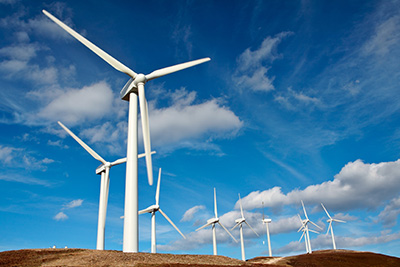What is a Carbon Footprint and How to Reduce It

Earth is the only planet we have to call home, so it’s our responsibility to take care of it. We all know some basic steps we can take to safeguard the environment – recycling, taking public transit, shopping with reusable bags, driving an electric vehicle – but some of the most significant changes we can make involve the way we use energy at home.
What Is a Carbon Footprint?
Some of the actions we perform every day generate greenhouse gas emissions – carbon dioxide, methane and other gasses that heat up the air in the earth’s atmosphere. The measure of these greenhouse gas emissions is called a carbon footprint. We use carbon footprints to assess the environmental impact of humanity as a whole, but we also use them to size up the environmental effects of countries, households and individuals.
In the U.S., the average carbon footprint for a person is about 16 tons, according to The Nature Conservancy. That’s one of the highest rates in the world, compared to a global average carbon footprint of about four tons. To avoid a catastrophic increase in atmospheric temperature, climate scientists recommend a goal of reducing the global average carbon footprint to two tons by 2050.
Carbon Footprint Reduction
There are opportunities to reduce your carbon footprint all over your home. Some of these may make only a small difference on their own, but if you add them all up, you can expect your carbon footprint from household energy to shrink significantly. And your energy bills will shrink, too!
Heating and Cooling
Climate control systems like furnaces and air conditioners account for a large share of the energy consumption in a typical home. And when they fall into disrepair and run less efficiently, the energy consumption goes up even higher. So it’s important to maintain these systems diligently with annual inspections and tune-ups by licensed professionals.
HVAC maintenance: When it comes to air conditioner and furnace efficiency, annual maintenance is key. Annual inspections and tune ups from a licensed professional help your HVAC system run efficiently and last longer. During your service appointment, your HVAC technician should be able to show you everything you need to do to your system to keep it in good working order. In many homes, this is a simple matter of replacing disposable air filters on a schedule and keeping any outdoor HVAC equipment free of leaves and debris. The other important responsibility is to take fast action whenever you suspect a problem with your system, because some small problems can quickly turn into large ones.
Upgrade your thermostat: Upgrading your thermostat to a programmable model (or better yet, a smart thermostat) can help you conserve energy by allowing heating and cooling schedules. When you’re home, it’s a good idea to set your thermostat around 68 degrees Fahrenheit in the winter and 78 degrees in the summer. But when you’re away, you can adjust these temperatures by about 10 degrees to save a lot of energy. With a smart thermostat, you can also control your thermostat remotely with a smartphone app.
Check your ducts for leaks: If your home has ductwork, it may be leaking air, which can reduce your system’s efficiency. You can check for leaks by looking for gaps in the sections of ductwork you can access, or by holding out your hand to feel for a flow of air. You can also hire an HVAC company to conduct a pressure test that will assess your ductwork for leaks. Some of these companies can seal leaks from the inside by circulating a rubberized mist throughout your ducts, forming a durable membrane. But for accessible sections of ductwork, you can often make an effective patch using aluminum foil tape.
Plan your HVAC replacement: You should also plan to replace your heating and cooling systems proactively, and discuss your replacement timeline with the technicians who service your system. A furnace will typically last 15 to 20 years, and an air conditioner’s lifespan is about 10 to 15 years. Even a well cared-for system will lose efficiency over time.
When shopping for replacement equipment, pay attention to efficiency ratings. With air conditioners, this is called the seasonal energy efficiency ratio, or SEER rating. With furnaces, it’s the average fuel utilization efficiency, or AFUE. The higher the number, the more efficient the unit.
Major Appliances
Just as with heating and cooling equipment, most major appliances lose energy efficiency over time. This is especially true for refrigerators, which should generally be replaced every 10 to 15 years. Make a plan for the timely replacement of refrigerators, ovens, dishwashers, washing machines and dryers to avoid wasting energy with aging equipment.
When shopping for appliances, look for the yellow and black EnergyGuide label. This label will show you standardized energy consumption data, as well as an estimate of the annual operating cost. This makes it easy to compare the energy efficiency of appliances of the same type. Another label to keep an eye out for is the blue and white ENERGY STAR label. Appliances with this label have passed high energy efficiency benchmarks, helping you narrow your search to only the most efficient models.
Giving each of your appliances a deep cleaning at least every six months can help them run more efficiently. Again, this is most important with refrigerators, which can gather dust on their cooling coils and compressor. Be sure to clean behind and underneath your refrigerator with a long-handled dusting tool. Check out some of our best cost-saving tips for home refrigeration.
Refrigerators run more efficiently when they’re full than when they’re empty, but they shouldn’t be so full that it inhibits airflow. You should set your refrigerator’s temperature between 35 and 38 degrees Fahrenheit, according to the Department of Energy.
Dishwashers tend to use less energy than hand-washing, so you should use your dishwasher whenever possible, taking care to only wash full loads. And with your clothes dryer, stick to low-heat settings or try hang drying whenever possible to cut down on energy use.
Water Heating

Tank-style water heaters are also major energy users that get less efficient with time. They last 8 to 12 years on average, and should be flushed and inspected annually to keep them running as efficiently as possible. Water heaters also feature the EnergyGuide and ENERGY STAR labels, so be sure to look for them when planning for replacement. Depending on your budget, you might consider water heater styles that are more efficient overall, including tankless water heaters and solar water heaters.
Adding an insulated jacket to the outside of your water heater’s tank can help improve its efficiency, and keeping the thermostat set to 120 degrees Fahrenheit will help reduce its energy consumption. Setting the thermostat lower than 120 is not recommended because of the risk of bacteria development.
Replacing your water fixtures with low-flow showerheads and aerated faucets can help reduce your overall water consumption. This of course reduces your hot water demand, which will save even more energy.
Weatherization
No matter how energy efficient your HVAC equipment is, you’ll still end up wasting energy if you live in a leaky home. It’s important to periodically check for cracks in walls and concrete that may be allowing airflow, and to seal them up when they form. Air can also leak around plumbing pipes that extend through walls, but these can usually be sealed with spray foam.
The weather stripping around your doors and windows can become dry and brittle over time, allowing air to seep through. You can test the integrity of your weather stripping by closing a dollar bill in your doors and windows and trying to pull it out. If it slips out easily, you know it’s time to replace the stripping.
Old and inefficient windows and doors may need to be replaced entirely. Doors and windows have their own efficiency ratings to help you shop wisely, and should always be installed by professionals to ensure a proper fit.
Solar Energy
You can take a major bite out of your home’s energy consumption by supplementing it with rooftop solar panels. Depending on your energy needs and the size of your solar array, you might even be able to eliminate your daytime energy purchasing entirely. With the addition of a home battery, you can also save solar-generated electricity for use after dark or during power outages.
Home Energy Audit
If all of this seems overwhelming, consider scheduling a professional home energy audit. Also called a home energy assessment, this service is a series of tests designed to measure the energy efficiency of your home and produce specific recommendations to help you improve it. Technicians may conduct blower tests to assess the integrity of your home envelope, or use infrared cameras to look for air leaks. A proper audit will also include a thorough inspection of your home to identify repairs or replacements that can reduce your energy use. Understanding how your household uses energy is key to making smart, energy-saving decisions.
Chipping away at the size of your carbon footprint can be a big job, but it benefits more than just the environment. It also adds to the comfort and value of your home, while saving you money each month on your energy bills. If we all do our part to reduce our own carbon footprints, we can bring the global average down to safe levels and prevent climate change from worsening.
Looking for Something Specific?
Select a category to find resources for topics that interest you.
Select Category

Related Articles:

What Are Carbon Offsets?
Carbon offsets help account for the carbon emissions produced by your daily activities. These offsets go toward projects that have a positive impact on the environment, like reforestation or renewable energy production.
Read Article
What Is Renewable Energy, or Clean Energy?
It’s easy to think of renewable energy as cutting edge; we often associate it with solar panels and wind farms, and consider it to be the future of energy production. But this is only partially true.
Read Article
What Is Wind Energy?
From windmills to modern wind turbines, we've been using technology to harness the power of wind for centuries. Learn how wind energy works today and the advantages and disadvantages of this type of renewable energy.
Read ArticleWhat is a Carbon Footprint and How to Reduce It
Earth is the only planet we have to call home, so it’s our responsibility to take care of it. We all know some basic steps we can take to safeguard the environment – recycling, taking public transit, shopping with reusable bags, driving an electric vehicle – but some of the most significant changes we can make involve the way we use energy at home.
What Is a Carbon Footprint?
Some of the actions we perform every day generate greenhouse gas emissions – carbon dioxide, methane and other gasses that heat up the air in the earth’s atmosphere. The measure of these greenhouse gas emissions is called a carbon footprint. We use carbon footprints to assess the environmental impact of humanity as a whole, but we also use them to size up the environmental effects of countries, households and individuals.
In the U.S., the average carbon footprint for a person is about 16 tons, according to The Nature Conservancy. That’s one of the highest rates in the world, compared to a global average carbon footprint of about four tons. To avoid a catastrophic increase in atmospheric temperature, climate scientists recommend a goal of reducing the global average carbon footprint to two tons by 2050.
Carbon Footprint Reduction
There are opportunities to reduce your carbon footprint all over your home. Some of these may make only a small difference on their own, but if you add them all up, you can expect your carbon footprint from household energy to shrink significantly. And your energy bills will shrink, too!
Heating and Cooling
Climate control systems like furnaces and air conditioners account for a large share of the energy consumption in a typical home. And when they fall into disrepair and run less efficiently, the energy consumption goes up even higher. So it’s important to maintain these systems diligently with annual inspections and tune-ups by licensed professionals.
HVAC maintenance: When it comes to air conditioner and furnace efficiency, annual maintenance is key. Annual inspections and tune ups from a licensed professional help your HVAC system run efficiently and last longer. During your service appointment, your HVAC technician should be able to show you everything you need to do to your system to keep it in good working order. In many homes, this is a simple matter of replacing disposable air filters on a schedule and keeping any outdoor HVAC equipment free of leaves and debris. The other important responsibility is to take fast action whenever you suspect a problem with your system, because some small problems can quickly turn into large ones.
Upgrade your thermostat: Upgrading your thermostat to a programmable model (or better yet, a smart thermostat) can help you conserve energy by allowing heating and cooling schedules. When you’re home, it’s a good idea to set your thermostat around 68 degrees Fahrenheit in the winter and 78 degrees in the summer. But when you’re away, you can adjust these temperatures by about 10 degrees to save a lot of energy. With a smart thermostat, you can also control your thermostat remotely with a smartphone app.
Check your ducts for leaks: If your home has ductwork, it may be leaking air, which can reduce your system’s efficiency. You can check for leaks by looking for gaps in the sections of ductwork you can access, or by holding out your hand to feel for a flow of air. You can also hire an HVAC company to conduct a pressure test that will assess your ductwork for leaks. Some of these companies can seal leaks from the inside by circulating a rubberized mist throughout your ducts, forming a durable membrane. But for accessible sections of ductwork, you can often make an effective patch using aluminum foil tape.
Plan your HVAC replacement: You should also plan to replace your heating and cooling systems proactively, and discuss your replacement timeline with the technicians who service your system. A furnace will typically last 15 to 20 years, and an air conditioner’s lifespan is about 10 to 15 years. Even a well cared-for system will lose efficiency over time.
When shopping for replacement equipment, pay attention to efficiency ratings. With air conditioners, this is called the seasonal energy efficiency ratio, or SEER rating. With furnaces, it’s the average fuel utilization efficiency, or AFUE. The higher the number, the more efficient the unit.
Major Appliances
Just as with heating and cooling equipment, most major appliances lose energy efficiency over time. This is especially true for refrigerators, which should generally be replaced every 10 to 15 years. Make a plan for the timely replacement of refrigerators, ovens, dishwashers, washing machines and dryers to avoid wasting energy with aging equipment.
When shopping for appliances, look for the yellow and black EnergyGuide label. This label will show you standardized energy consumption data, as well as an estimate of the annual operating cost. This makes it easy to compare the energy efficiency of appliances of the same type. Another label to keep an eye out for is the blue and white ENERGY STAR label. Appliances with this label have passed high energy efficiency benchmarks, helping you narrow your search to only the most efficient models.
Giving each of your appliances a deep cleaning at least every six months can help them run more efficiently. Again, this is most important with refrigerators, which can gather dust on their cooling coils and compressor. Be sure to clean behind and underneath your refrigerator with a long-handled dusting tool. Check out some of our best cost-saving tips for home refrigeration.
Refrigerators run more efficiently when they’re full than when they’re empty, but they shouldn’t be so full that it inhibits airflow. You should set your refrigerator’s temperature between 35 and 38 degrees Fahrenheit, according to the Department of Energy.
Dishwashers tend to use less energy than hand-washing, so you should use your dishwasher whenever possible, taking care to only wash full loads. And with your clothes dryer, stick to low-heat settings or try hang drying whenever possible to cut down on energy use.
Water Heating
Tank-style water heaters are also major energy users that get less efficient with time. They last 8 to 12 years on average, and should be flushed and inspected annually to keep them running as efficiently as possible. Water heaters also feature the EnergyGuide and ENERGY STAR labels, so be sure to look for them when planning for replacement. Depending on your budget, you might consider water heater styles that are more efficient overall, including tankless water heaters and solar water heaters.
Adding an insulated jacket to the outside of your water heater’s tank can help improve its efficiency, and keeping the thermostat set to 120 degrees Fahrenheit will help reduce its energy consumption. Setting the thermostat lower than 120 is not recommended because of the risk of bacteria development.
Replacing your water fixtures with low-flow showerheads and aerated faucets can help reduce your overall water consumption. This of course reduces your hot water demand, which will save even more energy.
Weatherization
No matter how energy efficient your HVAC equipment is, you’ll still end up wasting energy if you live in a leaky home. It’s important to periodically check for cracks in walls and concrete that may be allowing airflow, and to seal them up when they form. Air can also leak around plumbing pipes that extend through walls, but these can usually be sealed with spray foam.
The weather stripping around your doors and windows can become dry and brittle over time, allowing air to seep through. You can test the integrity of your weather stripping by closing a dollar bill in your doors and windows and trying to pull it out. If it slips out easily, you know it’s time to replace the stripping.
Old and inefficient windows and doors may need to be replaced entirely. Doors and windows have their own efficiency ratings to help you shop wisely, and should always be installed by professionals to ensure a proper fit.
Solar Energy
You can take a major bite out of your home’s energy consumption by supplementing it with rooftop solar panels. Depending on your energy needs and the size of your solar array, you might even be able to eliminate your daytime energy purchasing entirely. With the addition of a home battery, you can also save solar-generated electricity for use after dark or during power outages.
Home Energy Audit
If all of this seems overwhelming, consider scheduling a professional home energy audit. Also called a home energy assessment, this service is a series of tests designed to measure the energy efficiency of your home and produce specific recommendations to help you improve it. Technicians may conduct blower tests to assess the integrity of your home envelope, or use infrared cameras to look for air leaks. A proper audit will also include a thorough inspection of your home to identify repairs or replacements that can reduce your energy use. Understanding how your household uses energy is key to making smart, energy-saving decisions.
Chipping away at the size of your carbon footprint can be a big job, but it benefits more than just the environment. It also adds to the comfort and value of your home, while saving you money each month on your energy bills. If we all do our part to reduce our own carbon footprints, we can bring the global average down to safe levels and prevent climate change from worsening.
Looking for Something Specific?
Select a category to find resources for topics that interest you.
Select Category

Related Articles:

What Are Carbon Offsets?
Carbon offsets help account for the carbon emissions produced by your daily activities. These offsets go toward projects that have a positive impact on the environment, like reforestation or renewable energy production.
Read Article
What Is Renewable Energy, or Clean Energy?
It’s easy to think of renewable energy as cutting edge; we often associate it with solar panels and wind farms, and consider it to be the future of energy production. But this is only partially true.
Read Article
What Is Wind Energy?
From windmills to modern wind turbines, we've been using technology to harness the power of wind for centuries. Learn how wind energy works today and the advantages and disadvantages of this type of renewable energy.
Read Article






